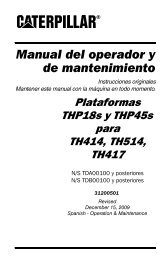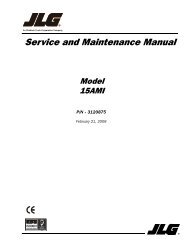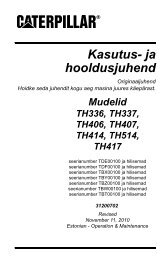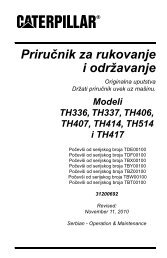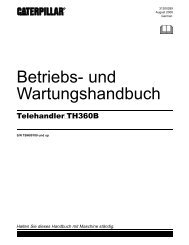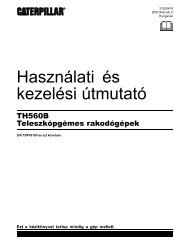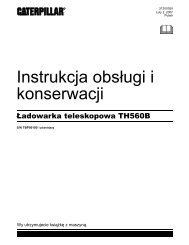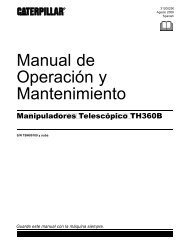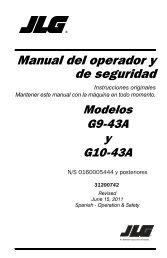Operation and Maintenance Manual
Engine - JLG
Engine - JLG
- No tags were found...
Create successful ePaper yourself
Turn your PDF publications into a flip-book with our unique Google optimized e-Paper software.
44 SEBU8180-01<br />
<strong>Operation</strong> Section<br />
Engine Starting<br />
2. Connect one positive end of the jump start cable<br />
to the positive cable terminal of the discharged<br />
battery. Connect the other positive end of the jump<br />
start cable to the positive cable terminal of the<br />
electrical source.<br />
After Starting Engine<br />
SMCS Code: 1000<br />
i02330138<br />
3. Connect one negative end of the jump start cable<br />
to the negative cable terminal of the electrical<br />
source. Connect the other negative end of the<br />
jump start cable to the engine block or to the<br />
chassis ground. This procedure helps to prevent<br />
potential sparks from igniting the combustible<br />
gases that are produced by some batteries.<br />
4. Start the engine.<br />
5. Immediately after the engine is started, disconnect<br />
the jump start cables in reverse order.<br />
After jump starting, the alternator may not be able to<br />
fully recharge batteries that are severely discharged.<br />
The batteries must be replaced or charged to the<br />
proper voltage with a battery charger after the engine<br />
is stopped. Many batteries which are considered<br />
unusable are still rechargeable. Refer to <strong>Operation</strong><br />
<strong>and</strong> <strong>Maintenance</strong> <strong>Manual</strong>, “Battery - Replace” <strong>and</strong><br />
Testing <strong>and</strong> Adjusting <strong>Manual</strong>, “Battery - Test”.<br />
Refer to the Electrical Schematic for your engine.<br />
Consult your Caterpillar dealer for more information.<br />
Note: In ambient temperatures from 0 to 60°C<br />
(32 to 140°F), the warm-up time is approximately<br />
three minutes. In temperatures below 0°C (32°F),<br />
additional warm-up time may be required.<br />
When the engine idles during warm-up, observe the<br />
following conditions:<br />
Do not check the high pressure fuel lines with the<br />
engine or the starting motor in operation. If you<br />
inspect the engine in operation, always use the<br />
proper inspection procedure in order to avoid a<br />
fluid penetration hazard. Refer to <strong>Operation</strong> <strong>and</strong><br />
<strong>Maintenance</strong> <strong>Manual</strong>, “General hazard Information”.<br />
• Check for any fluid or for any air leaks at idle rpm<br />
<strong>and</strong> at one-half full rpm (no load on the engine)<br />
before operating the engine under load. This is not<br />
possible in some applications.<br />
• Allow the engine to idle for three to five minutes, or<br />
allow the engine to idle until the water temperature<br />
indicator begins to rise. Check all gauges during<br />
the warm-up period.<br />
Note: Gauge readings should be observed <strong>and</strong><br />
the data should be recorded frequently while the<br />
engine is operating. Comparing the data over time<br />
will help to determine normal readings for each<br />
gauge. Comparing data over time will also help<br />
detect abnormal operating developments. Significant<br />
changes in the readings should be investigated.



